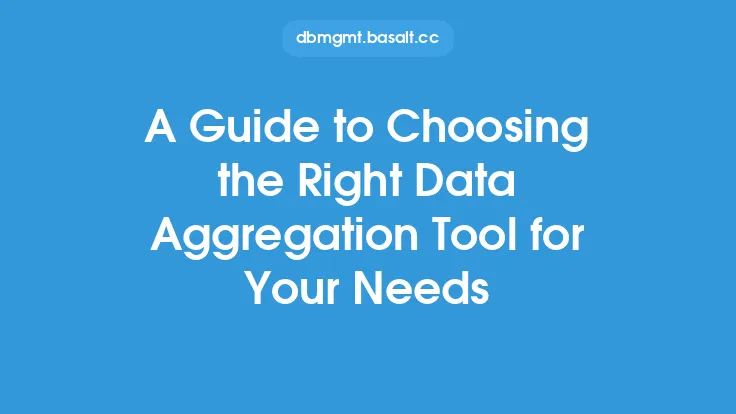When it comes to database management, one of the most critical aspects is ensuring the integrity and availability of data. Backup and recovery tools play a vital role in achieving this goal. With so many options available in the market, choosing the right backup and recovery tool can be a daunting task. In this article, we will provide a comprehensive guide to help you make an informed decision.
Understanding Your Database Environment
Before selecting a backup and recovery tool, it's essential to understand your database environment. This includes the type of database management system (DBMS) you are using, the size of your database, the complexity of your data, and the level of security required. Different databases have different backup and recovery requirements, and understanding these requirements is crucial in choosing the right tool. For example, a relational database like MySQL or Oracle may require a different backup and recovery approach than a NoSQL database like MongoDB.
Evaluating Your Backup and Recovery Needs
Once you have a clear understanding of your database environment, the next step is to evaluate your backup and recovery needs. This includes determining the frequency of backups, the type of backups required (full, incremental, or differential), and the retention period for backups. You should also consider the recovery time objective (RTO) and recovery point objective (RPO) for your database. RTO refers to the maximum amount of time that your database can be offline after a disaster, while RPO refers to the maximum amount of data that can be lost in the event of a disaster.
Assessing Tool Compatibility and Integration
Another critical factor to consider when choosing a backup and recovery tool is compatibility and integration. The tool should be compatible with your DBMS and operating system, and should integrate seamlessly with your existing infrastructure. You should also consider the level of support provided by the tool vendor, including documentation, training, and technical support. Additionally, the tool should be able to handle different data formats and should be able to backup and recover data from different locations, such as on-premise, cloud, or hybrid environments.
Considering Scalability and Performance
As your database grows, your backup and recovery tool should be able to scale to meet the increasing demands. The tool should be able to handle large volumes of data and should be able to perform backups and recoveries quickly and efficiently. You should also consider the tool's ability to handle concurrent backups and recoveries, as well as its ability to prioritize backups and recoveries based on business requirements. Furthermore, the tool should be able to provide real-time monitoring and reporting, allowing you to track the status of backups and recoveries and make informed decisions.
Looking for Security and Encryption Features
Security and encryption are critical features to consider when choosing a backup and recovery tool. The tool should be able to encrypt data both in transit and at rest, and should provide secure authentication and authorization mechanisms. You should also consider the tool's ability to comply with regulatory requirements, such as GDPR, HIPAA, and PCI-DSS. Additionally, the tool should be able to provide role-based access control, allowing you to restrict access to sensitive data and ensure that only authorized personnel can perform backups and recoveries.
Checking for Cloud and Virtualization Support
In today's digital age, many organizations are moving their databases to the cloud or virtualized environments. When choosing a backup and recovery tool, you should consider its ability to support cloud and virtualization platforms, such as Amazon Web Services (AWS), Microsoft Azure, and VMware. The tool should be able to backup and recover data from these platforms, and should provide seamless integration with cloud-based storage services, such as Amazon S3 and Microsoft Azure Blob Storage.
Reviewing Vendor Support and Community
Finally, when choosing a backup and recovery tool, you should consider the level of support provided by the vendor and the community surrounding the tool. The vendor should provide comprehensive documentation, training, and technical support, including online forums, knowledge bases, and phone support. You should also consider the size and activity of the community surrounding the tool, including the number of users, the frequency of updates, and the availability of third-party plugins and integrations.
Conclusion
Choosing the right backup and recovery tool is a critical decision that can have a significant impact on the integrity and availability of your database. By understanding your database environment, evaluating your backup and recovery needs, assessing tool compatibility and integration, considering scalability and performance, looking for security and encryption features, checking for cloud and virtualization support, and reviewing vendor support and community, you can make an informed decision and ensure that your database is protected and recoverable in the event of a disaster. Remember to always prioritize your specific needs and requirements, and to carefully evaluate each tool's features and capabilities before making a decision.





